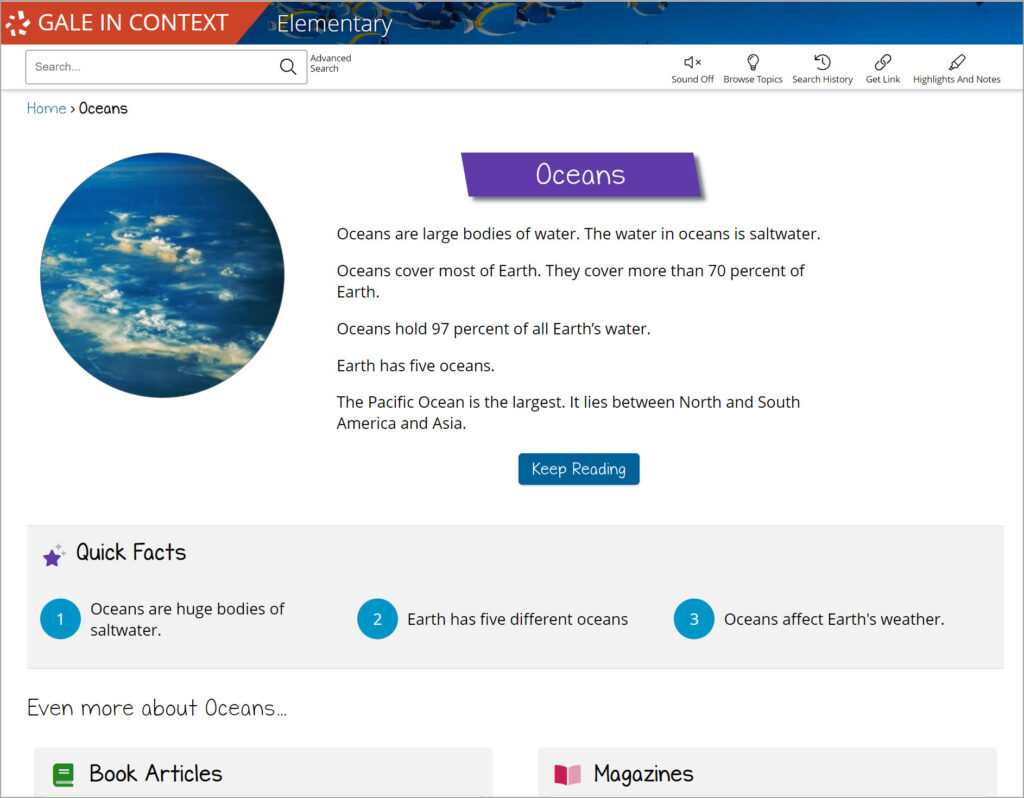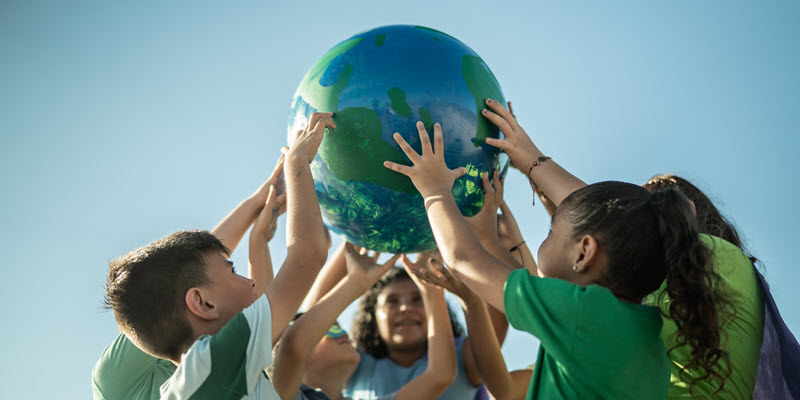| By Gale Staff |
April may have Earth Day and Arbor Day, but why limit our love for the planet to one month? This June, K-12 teachers can bring World Oceans Day and World Environment Day into their classrooms, broadening their students’ curiosity and appreciation for our Earth. Monday, June 5, is World Environment Day, and Thursday, June 8, is World Oceans Day. Gale’s databases are teeming with resources and ideas for teachers aspiring to recognize these holidays. To help you prepare, our team has developed themed student activities that integrate effortlessly into your lesson plans!
Gamify Research Skills
Come June, students are gearing up for summer and are no doubt ready for more lighthearted and fun classroom activities. Moreover, we know teachers work hard all year round, so we try to make their lives a little easier with Content Specific Training Materials organized by month. We’ve just launched our curated collection for World Environment Day and World Oceans Day, featuring direct links to relevant K-12 databases. Plus, find printable lessons and activities, including alternative energy trading cards and ocean creatures trading cards.
ocean-day-kib-trading-cardsFor more classroom fun, take advantage of our pollution scavenger hunt, which guides elementary students through a series of information-seeking tasks. This scavenger hunt approach helps gamify research, which in turn gets young students more excited to learn. These tools can help develop the basic research aptitudes they’ll need for future academic success. For older kids, leverage an alternative energy tic-tac-toe board. To win, participants must complete a series of challenges, such as creating a poster to educate others about an alternative energy source or illustrating a comic strip that shows the basic science behind an alternative energy method.
Dive Into World Oceans Day
Gale In Context: Elementary is a comprehensive database for World Oceans Day research designed specifically for children. Our oceans are fascinating! Your students just need to dip their research toes into our oceans portal, and their natural curiosity will sail off with the tide. Start with the summary page so students can get oriented with the sheer size of Earth’s ocean ecosystems. Oceans cover 70% of the Earth’s surface and, at certain spots, are deeper than Mount Everest is tall.

Once students are more familiar with the scope and diversity of our oceans, challenge them to discuss why humans must protect these ecosystems. The ocean is vital to the air we breathe and the water we drink. We love to play in and explore our oceans, and they’re crucial to many industries. The mission of World Oceans Day is not only to celebrate the world’s oceans but to build awareness about their importance.
Discussion Idea: Have students read about the Great Pacific Garbage Patch to better understand the scale of ocean pollution. Then, learn about ocean conservation, and as a class, brainstorm ways in which humans can be part of the solution. As students head off for summer vacation, remind them to be mindful of the waste they leave behind at the beach. Maybe even sign a pledge as a class.
Introduce Middle Schoolers to Environmentalism
While the oceans are a captivating topic for any age group, middle school educators may choose to expand their lesson plans to include a larger conversation about our environment. Celebrate World Environment Day by introducing middle school learners to environmentalism. Explore the environmental portal in Gale In Context: Middle School to discover age-appropriate content that challenges users’ research abilities while delivering a highly visual, guided experience.
In honor of World Environment Day, ask middle school students to consider the relationship between humans and the environment. People rely on the environment. We need the planet’s clean water, fresh air, food, and shelter to survive. Ask your students—what do we then owe the environment in return? Discuss our waste footprint and strategies that individuals use to minimize trash. Research air pollution and how air quality differs depending on where we live. There are many ways to approach environmentalism, and Gale has the resources your students need to understand this vast, yet important concept.
Discussion Idea: This year’s theme for World Environment Day is #BeatPlasticPollution. As such, teachers might direct their students to the plastic pollution portal in Middle School. As a class, identify ways your school might decrease its plastic waste. Maybe even draft a letter to the school administration and ask them to consider some of the ideas.
Learn About the Science Behind Sustainability
Your high school students are ready for more challenging concepts, so why not integrate renewable energy science, climate change impacts, and other sustainability discussions into your World Environment Day planning? High school teachers can direct students to two separate Gale resources: Gale In Context: High School and Gale In Context: Environmental Studies.
Introduce high schoolers to the global warming and climate change portal in Gale In Context: High School. Here, they’ll find featured content from major news outlets, reference materials, and thousands of other vetted, reliable pieces. Your teenage students can handle discussions around more nuanced topics, such as immigration tensions around climate refugees, environmental justice for low-income communities, or the financial accountability to which world nations should commit to address climate change. These subjects can be difficult, if not sometimes controversial, but the next generation must know how to discuss and identify accurate information about these issues.
For a more targeted, interdisciplinary approach to World Environment Day, check out the renewable energy portal and sustainable development portal in Gale In Context: Environmental Studies. This resource is dedicated to housing authoritative and accurate resources related to the environment and sustainability. High school students preparing for college and considering their career paths can benefit from the database’s comprehensive approach. Whether an aspiring architect, engineer, businessperson, or environmental activist, users will appreciate the well-organized yet diverse content.
Activity Idea: Have your high schoolers research how climate change and sustainability may interact with their future careers. For example, how might resources be limited for a certain industry or company? How might government ethics change? Using Gale resources, have them draft a short response with these reflections.
Make learning fun and celebrate World Oceans Day and World Environment Day this June! Rely on Gale’s databases and teacher-friendly resources to make your job a little easier as you round out the school year. If your school isn’t a current subscriber, contact your local Gale representative to learn more about our products.

